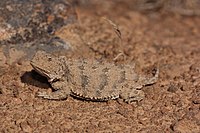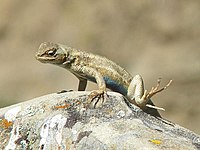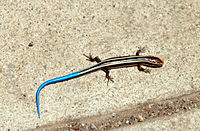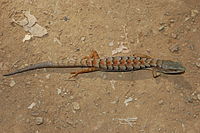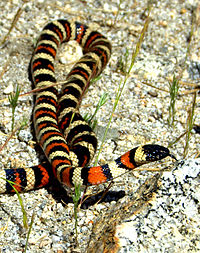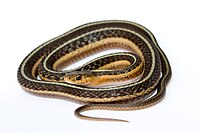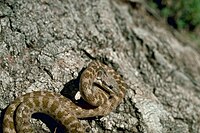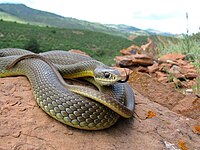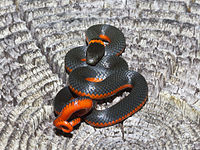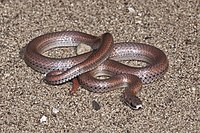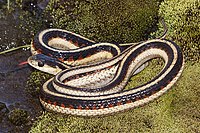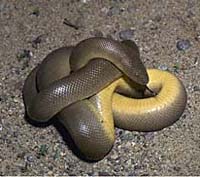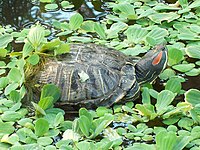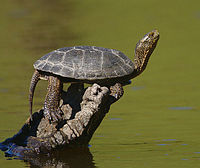
Herpetology is a branch of zoology concerned with the study of amphibians and reptiles. Birds, which are cladistically included within Reptilia, are traditionally excluded here; the separate scientific study of birds is the subject of ornithology.

Amphetamine Reptile Records is a record label founded in 1986 by Tom Hazelmyer in Washington state. The label specializes in noise rock and also released Strap It On, the debut album by alternative metal band Helmet which sold more than 40,000 records. According to Hazelmyer, the success of the album was vital to keeping AmRep going throughout the 1990s, as it "helped support the other things that sold less." The label was the subject of the 2015 documentary The Color of Noise.

In biology, a common name of a taxon or organism is a name that is based on the normal language of everyday life; and is often contrasted with the scientific name for the same organism, which is often based in Latin. A common name is sometimes frequently used, but that is not always the case.

Agkistrodon piscivorus is a species of venomous snake, a pit viper in the subfamily Crotalinae of the family Viperidae. It is one of the world's few semiaquatic vipers, and is native to the Southeastern United States. As an adult, it is large and capable of delivering a painful and potentially fatal bite. When threatened, it may respond by coiling its body and displaying its fangs. Individuals may bite when feeling threatened or being handled in any way. It tends to be found in or near water, particularly in slow-moving and shallow lakes, streams, and marshes. It is a capable swimmer, and like several species of snakes, is known to occasionally enter bays and estuaries and swim between barrier islands and the mainland.

The Blanding's turtle is a semi-aquatic turtle of the family Emydidae. This species is native to central and eastern parts of Canada and the United States. It is considered to be an endangered species throughout much of its range. The Blanding's turtle is of interest in longevity research, as it shows few or no common signs of aging and is physically active and capable of reproduction into eight or nine decades of life.

Reptile is a character in the Mortal Kombat fighting game franchise by Midway Games and NetherRealm Studios. He debuted in the original 1992 game as a hidden opponent, establishing him as the first secret character in fighting game history. Reptile became playable in the follow-up Mortal Kombat II (1993) and has remained a mainstay of the franchise. As implied by his name, he is a Saurian, a fictional species of reptilian humanoids. One of the last surviving members of his race, he aligns himself with the series' primary villains in the hope his service will lead to the Saurians' revival.

The Borneo python, also known commonly as the Borneo short-tailed python, is a species of non-venomous snake in the family Pythonidae. The species is endemic to the island of Borneo.

Karl Patterson Schmidt was an American herpetologist.

Crotalus oreganus, commonly known as the Western rattlesnake or northern Pacific rattlesnake, is a venomous pit viper species found in western North America from the Baja California Peninsula to the southern interior of British Columbia.
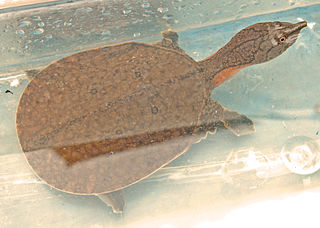
The Malayan softshell turtle is a species of softshell turtle in the family Trionychidae. It is monotypic in its genus.
The spotted box turtle is a species of turtle in the family Emydidae. The species is endemic to the Sierra Madre Occidental in Mexico.

Crotalus stejnegeri, commonly known as the Sinaloan long-tailed rattlesnake or just long-tailed rattlesnake, is a venomous pit viper species in the family Viperidae. The species is native to western Mexico. There are no recognized subspecies.
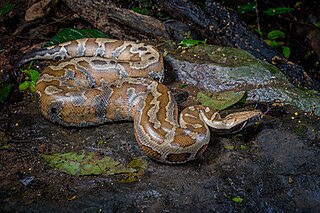
Python brongersmai is a species of nonvenomous snake in the family Pythonidae. The species is native to Southeast Asia.

Doris Mable Cochran was an American herpetologist and custodian of the American Natural Collection at the Smithsonian Institution in Washington, D.C., for many years.
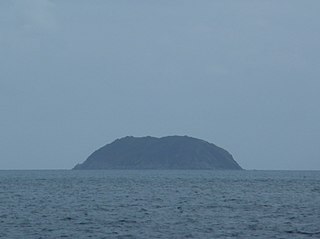
Round Rock is an uninhabited island in the British Virgin Islands, to the south of Virgin Gorda, east of Ginger Island and close to Fallen Jerusalem Island.

Located in southwestern Washington and northwestern Oregon, United States, the Julia Butler Hansen Refuge for the Columbian White-Tailed Deer is a wildlife refuge. It was established in 1972 specifically to protect and manage the endangered Columbian white-tailed deer. The refuge contains over 5,600 acres (23 km2) of pastures, forested tidal swamps, brushy woodlots, marshes, and sloughs along the Columbia River in both Washington and Oregon.

Aubry's flapshell turtle is a species of softshell turtle in the family Trionychidae. The species is endemic to Central Africa.
The Chennai Snake Park, officially the Chennai Snake Park Trust, is a not-for-profit NGO constituted in 1972 by herpetologist Romulus Whitaker and is India's first reptile park. Also known as the Guindy Snake Park, it is located next to the Children's Park in the Guindy National Park campus. Located on the former home of the Madras Crocodile Bank Trust, the park is home to a wide range of snakes such as adders, pythons, vipers, cobras and other reptiles. The park gained statutory recognition as a medium zoo from the Central Zoo Authority in 1995.

The Volcán Wolf giant tortoise, also known commonly as the Wolf Volcano giant tortoise and the Cape Berkeley giant tortoise, is a subspecies of Galápagos tortoise in the family Testudinidae. The subspecies is native to the north side of Ecuador's Isabela Island. Chelonoidis becki has links to two different lineages including that of Chelonoidis darwini from the nearby island of Santiago. C. becki has been found to be the product of a double colonization event beginning around 199,000 years ago, and had been formed through introgression, where greater male selectivity was exhibited by purebred females in one of the lineages. It is most commonly found on the northern, western, and southwestern slopes of Volcán Wolf, the volcano that it is named for. Having evolved to live in a specific environment, C. becki only occupies an estimated range of about 263 square kilometers. An estimated 1,150 Volcán Wolf giant tortoises inhabit Volcán Wolf.
